Why Do The Cars From "Cars" Have Teeth?
April 10, 2025
My son is three years old, and he is obsessed with vehicles. It started with trains––YouTube videos of steam engines and high-speed Japanese passenger rail. Then he became obsessed with fire trucks, construction equipment, buses. Cars with jobs. He loves every motorized vehicle he’s ever seen. Even, unfortunately, Cybertrucks (he doesn’t know they’re evil yet).
Naturally, he also loves Disney/Pixar’s Cars.
I’m not sure I’d ever seen Cars in its entirety until I had kids, though I was aware of its release in 2006. I worked at Claire’s in my hometown mall back then, and the Rascall Flatts cover of “Life is a Highway” from the film’s soundtrack featured heavily on our in-store playlist. But now I know far more than I ever thought possible about Cars. My child eschews Bluey, Blippi, Daniel Tiger, and even Elmo. He demands Lightning McQueen.
While not necessarily the strongest entry in the Pixar library, Cars has had incredible staying power. The 20-year-old franchise is still basically printing money, primarily through merchandising. My son has six different Cars toys, a t-shirt, and a jacket. You can get Cars Crocs, backpacks, lunchboxes, water bottles. I found an old article that said Cars had made Disney/Pixar $10 billion as of 2011. That was before the sequels, before Cars Land opened at Disney California Adventure. At this point, Cars is its own mini-economy.

Prius McQueen spotted in Mongolia via the Kachow subreddit. Kachow is Lightning McQueen's catchphrase.
One night, my kid plopped the largest of his Cars on the dining room table as he sat down to eat. We usually don’t do toys at the table, but it wasn’t the particular hill I wanted to die on that evening, so I issued his car a formal invite to dine with us. My son responded disdainfully, “Mommy, Lighting The Queen is NOT a person.”
But I’m not so sure my toddler is right. When you’ve spent as much time immersed in Cars as I have, you may find yourself asking existential questions about their universe. Your mind wanders. Lightning McQueen is a car, that much is certain. But as an anthropomorphized car, we must ask: At what point does McQueen become human? Where is the line between human and car? Were there ever humans in the cars universe?
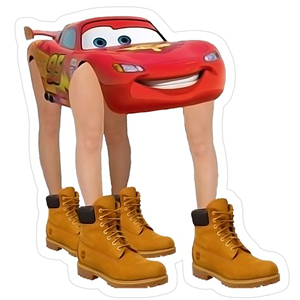
Lightning McQueen with human legs via Redbubble.
And the question that haunts me most of all: If the cars only consume gas, why does Mater have teeth?
An introduction to the Cars universe
To fully understand the arguments I am about to make, you’ll need a bit of a crash course on the Cars universe (pun semi-intended but I'm not proud of it).
Cars (2006): A young, cocky racecar named Lightning McQueen (Owen Wilson) is headed to California to break a three-way tie in racing’s most prestigious event, the Piston Cup, when disaster strikes and he’s stranded in small-town Radiator Springs along Route 66 (in what appears to be Arizona, though they never say this). He is arrested after accidentally destroying half of the town, and the judge sentences him to community service. He can leave once he’s repaved the road.
While in Radiator Springs, Lightning McQueen learns about the power of community, and also about the impact of the Interstate Highway System on towns along Route 66. He finds a friend in a redneck tow truck (Larry the Cable Guy), and a mentor in the town judge who turns out to be a reclusive famous racer (Paul Newman).
And then there’s the love interest, Sally. “Get a load of the sleek Porsche (Bonnie Hunt gives her a seductive purr) that gets Lightning’s engine humming,” wrote Peter Travers in a 2006 review of Cars for Rolling Stone. “Auto-eroticism takes on new meaning here.”
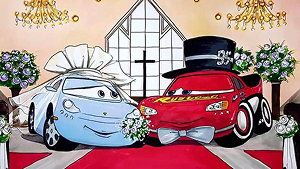
Fan art of Lightning McQueen and Sally's wedding day via DeviantArt.
First of all, obviously, what the fuck, but this crude take on Lightning and Sally’s extremely chaste relationship raises a lot of related questions about sex and gender. Are the cars demonstrating socialized gender characteristics, or do they have different biological sexes? What makes a car male or female? Are there nonbinary and transgender Cars? Moreover, while we see child cars and elderly cars, we never learn how the cars reproduce. How babby car formed?
(At this point I should mention for my fellow experts on the subject and those otherwise internet-poisoned: I have obviously read Jason Torchinsky’s Cars theory over at Jalopnik. I don’t agree with his conclusions, but I also think I am working with more information about the Cars universe than he would have had in 2017. But we’ll get to that. In any case, I don’t agree that they’re producing babies in vats and giving them automotive exoskeletons.)
In the end, Lightning McQueen doesn’t win the Piston Cup. He’s moments from crossing the finish line when retiring veteran Strip “The King” Weathers (racing legend Richard Petty) is deliberately run off the track by shit-talking Chick Hicks (Michael Keaton). McQueen doubles back to help The King cross the finish line, saying he “deserves to finish his final race.”
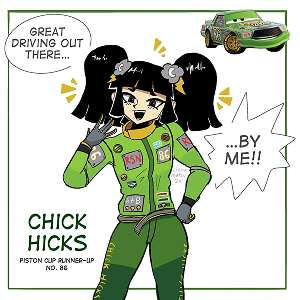
Fan art of Chick Hicks as a human by Reddit user flurbleburblenaut from the MoeMorphism subreddit, a community dedicated to "animating the inanimate."
Cute movie. Pretty good message. Well-positioned for a sequel.
(Here’s something I learned as I was writing this piece: One of the co-writers of Cars died in a car accident before the film’s release. Tens of thousands of Americans die in motor vehicle collisions each year, but it’s still kind of a spooky coincidence.)
Cars 2 (2011) is where things go completely off the rails.
British spy car Finn McMissile (Michael Caine) infiltrates an offshore oil rig, just in time to witness another spy car’s murder at the hands of some Car Henchmen. A murder in the opening scene! That’s right folks, the cars have guns and bombs now. By the end of this 106-minute movie, the kill count will be 26, or about one death every four minutes. Nobody dies in the first Cars movie, by the way.
Just as you’re thinking, “Is this supposed to be the sequel to that cute kids’ movie about Route 66?” we cut to Lightning McQueen in Radiator Springs, where he’s challenged to an international three-race series by an Italian F1 car (John Turturro). The series is a promotional tie-in for an alternative fuel developed by former oil tycoon-turned-environmentalist Sir Miles Axelrod (Eddie Izzard). All racers must use this fuel to participate.

Meme via Tumblr user hudson-whorenet.
Next we’re in Tokyo, where Mater publicly embarrasses Lightning McQueen. We learn that the alternative fuel explodes under the right circumstances, after three competitors blow up during the race. Mater is intercepted by the Michael Caine Car and his colleague (Emily Mortimer), who have mistaken him for an American spy.
When the cars travel internationally, we see them go through airport security, removing their tires and sending them through an x-ray machine before proceeding through a metal detector. I’m old enough to remember a time when you didn’t have to take off your shoes at the airport––we only started doing it in December 2001 after a would-be al-Qaeda suicide bomber tried to blow up a plane with his shoes.
We must logically conclude that if the cars have to take their tires off at the airport, it’s probably because there was a Tire Bomber. If we keep following that thread, if the Tire Bomber is a member of Cars al-Qaeda, then there’s a strong argument to be made that the Cars universe also experienced a 9/11-like event. And of course, if Cars al-Qaeda exists, it follows that there is a Cars Islam.
The cars then go to Italy, Mater does spy stuff, more cars explode, whatever. But also: The Car Pope is there, riding in a sentient Popemobile. So we have Cars Islam (implied) and what I’m gonna call Cartholicism (verified), both of which imply the existence of Cars Judaism. And there was a Cars World War II (we’ll get to that in a little bit), so was there a Cars Holocaust? You can see how with just a gentle tug of a loose thread, you suddenly unravel the entire Cars sweater.
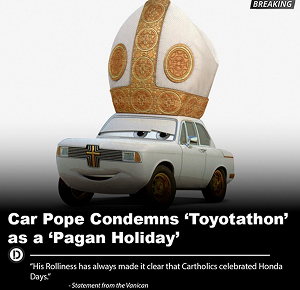
Via Tumblr, origin unknown.
I’ve also read some arguments suggesting that the existence of a Popemobile implies that someone must have tried to assassinate the Car Pope at some point. I think these claims are flimsy at best. Though they made the Popemobile bulletproof in 1981 after the attempted assassination of John Paul II, the concept of the Popemobile predates the attempt on the Pope’s life. Just an insane woman’s two cents.
Mater blows his cover and is captured in London, alongside the other spy cars. They’re held hostage inside Big Ben, which in the Cars universe is called Big Bentley, until Mater makes a daring escape.
The final race starts. We discover there’s a ticking time bomb under Mater’s hood, mistakenly installed by the Car Henchmen, who were trying to blow up McQueen. There’s a high speed chase ending in front of Buckingham Palace (which confusingly does NOT have an alternate name in the Cars universe), and we discover the evil mastermind behind this whole plot was Sir Miles Axelrod himself! He’s been blowing up cars because he still owns a bunch of oil refineries and wants to make alternative fuels seem unsafe, driving up demand for oil and making himself richer.
Axelrod is arrested. Mater is knighted by the Queen of England Car (Vanessa Redgrave). He and Lightning McQueen reconcile. Everyone returns to Radiator Springs. It is unclear what (if anything) it’s ultimately trying to say about oil, alternative fuels, or billionaires.

Cars 2 villain Miles Axelrod as a Cybertruck by Tumblr user haunted-planes.
The existence of fossil fuels in the Cars universe raises many additional questions, like: Where did the oil come from? Everything in the Cars universe is a vehicle. Even the flies are tiny cars with wings. Does the existence of oil imply there were, at some point, more carbon-based lifeforms inhabiting Lightning McQueen’s Earth?
Also, it clearly should have been Truckingham Palace. Someone call Pixar. Tell them I’m available.
Cars 3 (2017) picks up with no mention of the events of Cars 2.
We’re back in Radiator Springs alongside now seven-time Piston Cup winner Lightning McQueen as he starts a new racing season. But there’s a new generation of cars, led by cocky rookie Jackson Storm (Armie Hammer), and McQueen can’t keep up. His new sponsor (Nathan Fillion) wants him to retire, but ultimately agrees that McQueen can keep racing if he wins the upcoming Florida 500.
The sponsor also insists that McQueen train for the race with his top trainer, a young female sports car named Cruz Ramirez (Cristela Alonzo) who McQueen finds deeply annoying. That’s right, someone at Pixar decided girl cars get to race in this one. Unfortunately there’s no Peter Travers review, so we’ll never know if he thinks Cruz Ramirez is fuckable.
McQueen begins to soften on Cruz, and she admits she always wanted to be a racer but never had the confidence to follow through. They travel, prepare for the big race, meet some characters––like his old mentor’s crew chief (Chris Cooper) and the first female car to race in the Piston Cup (Margo Martindale).
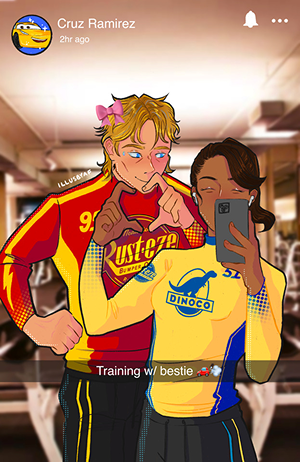
Cruz and McQueen as humans by Tumblr user illusbyaf.
At the Florida 500, Lightning McQueen has an epiphany. He steps aside and lets Cruz race in his place, and she beats Jackson Storm. So to recap, it’s a movie about a veteran male car stepping aside for a young female car who is (not to open a can of worms about ethnicity in the Cars universe) Latina. Imagine the shitstorm if they released this movie in 2025. Imagine the online discourse about how Pixar effectively neutered Lightning McQueen.
The extended Cars universe
Mater’s Tall Tales: Disney produced about a dozen cartoon shorts starring Mater between the release of the first two Cars movies. A non-exhaustive list of things he claims in these shorts: He invented heavy metal. He’s been to the moon. He can time travel. He was once a matador. He befriended a UFO. Obviously I do not consider any plot points within Mater’s Tall Tales to be canon to the Cars cinematic universe.
I really only mention these shorts because I think there’s an argument to be made that the events of Cars 2 could fit within this framework. Perhaps the events of Cars 2 only happened in Mater’s mind. But absent any confirmation from Pixar, I still consider Cars 2 canon.
Cars on the Road (2022): A bizarre (complimentary) 9-episode series on Disney+ in which Lightning McQueen and Mater take a cross-country road trip from Radiator Springs to Mater’s sister’s wedding. It has episodes based on The Shining and Mad Max, and a three-minute fever dream of a song about trucks that I assume is exactly what the inside of my three-year-old’s head is like.
But what I really want to call out is “Salt Fever,” episode 3 of Cars on the Road. In this episode, Mater meets the Speed Demon, which is the Cars Grim Reaper. He experiences what Wikipedia calls an “out-of-chassis experience” after racing too fast on the salt flats. And when he’s done chatting with the Speed Demon, his soul returns to his body through the driver’s side door, disproving the aforementioned Jalopnik theory that there’s a fucked up person inside the Cars. Jason Torchinsky, I eagerly await your rebuttal.
A note about the Planes movies
So I have never seen the Planes movies because they straight up look like shit. They were not produced by Disney and Pixar, but by Disneytoon Studios––a subsidiary of Disney that mostly released direct-to-video sequels like The Return of Jafar and The Lion King 1 1⁄2.
Planes (2013) and Planes: Fire and Rescue (2014) star Dane Cook as a small cropdusting plane named Dusty Crophopper. The first Planes movie has a 26% on Rotten Tomatoes.
The Planes movies feature a sports announcer car named Brent Mustangburger, who also appears in Cars 2. It’s a small role, mostly insignificant except for the fact that it tells us these films exist in the same universe.
The Planes movies also establish one very important historical fact: War exists in the Cars-Planes universe. It’s probably easiest to show you this short clip from Planes, which I once again must reiterate is a movie for children.
So that’s pretty clearly supposed to be the Battle of Guadalcanal during World War II. Assuming World War II played out the same in the Cars-Planes universe as it did in ours, that means Cars America went to war with Cars Hitler. Cars Hitler means Cars Holocaust.
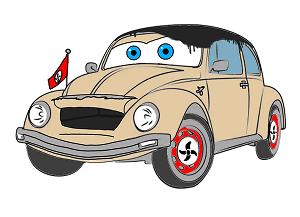
Here's a drawing of Cars Hitler I found on Reddit courtesy of u/juvy_ocerr
So what does it all mean?
We’ve already established I don’t think the cars from Cars have fucked up people inside them (the Jalopnik theory). But they’re not entirely cars either, at least not the kind of vehicles we have in our current reality. They have souls and teeth, but they only consume gasoline. How did they get here? And what are they exactly?
I’ve run through many potential theories. The very first iteration of this essay was actually a presentation for a PowerPoint party, and in that presentation I came to a completely different conclusion than I’m about to outline here.
I think my current theory might be pretty divisive, but I only ask one thing of you: If you’ve come with me on this journey so far, you’ve already accepted at least a dozen outlandish ideas. So indulge me.
The Creation Theory of the Cars Universe
I believe that Cars takes place on an Earth remarkably similar to ours, essentially a parallel universe that split at the end of the Cretaceous period. I believe in this universe, all life on Earth, plant and animal, died along with the dinosaurs.
And then: life sprung forth from the darkness. Mechanical life. The Cars. How did intelligent, mechanical life just appear on Earth? Intelligent design. The Cars God made it so.
I’m not here to debate the existence of a Cars God. For one, it’s not even the silliest thing asserted in this essay, or in the broader Cars universe. We’ve also established that the Cars themselves have religious belief systems, which means they believe in a Cars God. A creation myth would surely be part of their religious traditions.

(Side note: I am not the only person to have gone down this rabbit hole. I discovered a Cars fanfic wiki in which someone had written an entry for Jesus Chrysler.)
Which brings us back to our initial question: Are the Cars human? But what makes us human? Is it our bodies? Our minds? Our souls? Lightning McQueen has feelings and a soul. Is he less human than me because he has an engine instead of a heart? I guess that’s up to each of us to decide. The answers you seek lie within yourself.
And why do the cars have teeth? Because He created them that way.
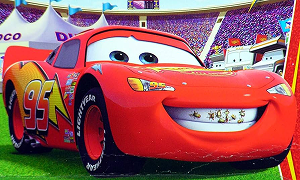
Mattel sells a small Lightning McQueen with bugs stuck in his teeth.
Praise Jesus Chrysler, amen.
A final word from my three-year-old
"Cars don't have skeletons," my son said to me at bedtime the other night. There was no context for this––if you've met a toddler you know that chatting with them is like riding the lazy river of consciousness through their minds. But clearly it was something he'd given great thought to.
"They could get hurt and fall apart," he added. My son, the young empath, worries that Lightning McQueen might feel pain. And perhaps from that perspective, it's important that we don't know too much about their physiology. What we don't know can't haunt us.
If you liked this post, you can sign up to receive updates when I publish new writing. Thank you for reading!